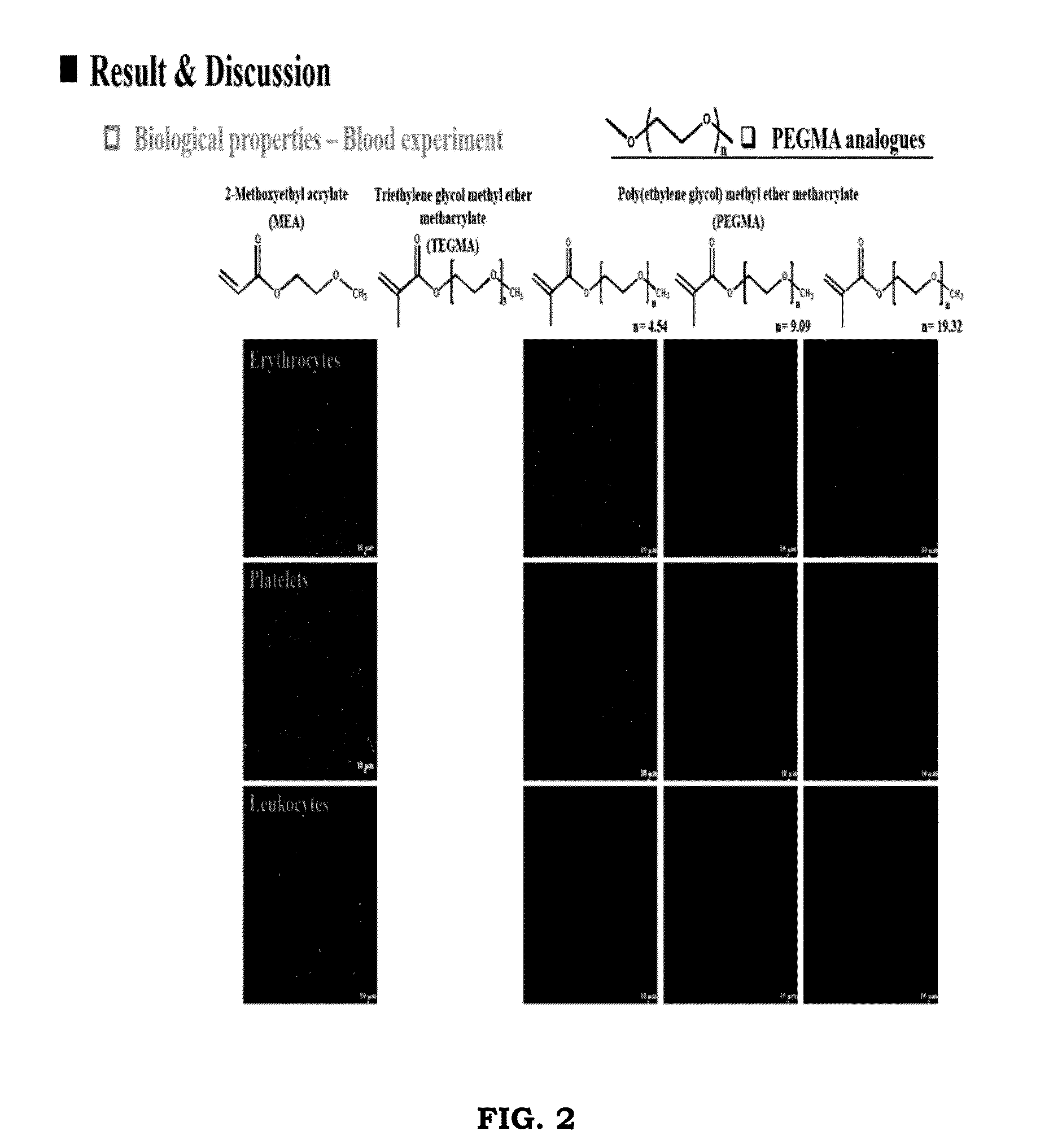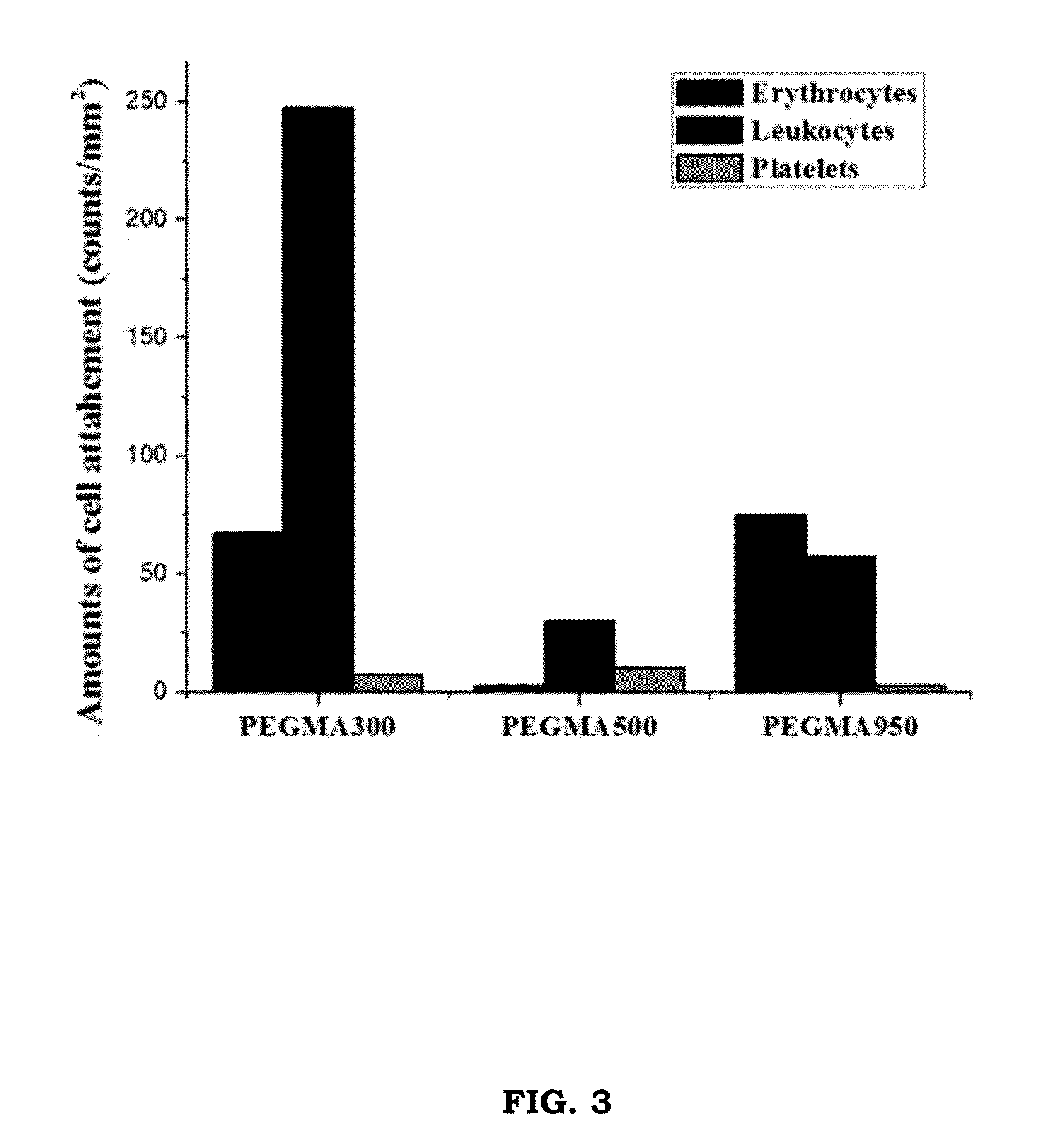Amine Modifying Material and Application thereof
a technology of amine modifying materials and hydrogels, applied in the field of hydrogels, can solve the problems of unwanted small molecules and the rapid absorption of peg-based hydrogels
- Summary
- Abstract
- Description
- Claims
- Application Information
AI Technical Summary
Benefits of technology
Problems solved by technology
Method used
Image
Examples
example 1
[0062]The synthesis of the amine modifying hydrogel I polymerized from dimethylaminoethyl methacrylate (DMAEMA), methoxypoly(ethylene glycol) methacrylate (PEGMA) has an average molecular weight of 500 Daltons and N,N-Methylenebisacrylamide.
[0063]The amine modifying hydrogel I polymerized from dimethylaminoethyl methacrylate (DMAEMA), and methoxypoly(ethylene glycol) methacrylate (PEGMA) has an average molecular weight of 500 Daltons is synthesized where “m” and “n” represent the molar ratio of P to D, respectively. For example, amine modifying hydrogel I: P20D80 represents the molar ratio of PEGMA to DMAEMA is 20:80. The same representation is also used in the following.
[0064]Dimethylaminoethyl methacrylate (DMAEMA) and methoxy poly(ethylene glycol) methacrylate (PEGMA) has an average molecular weight of 500 Daltons with a different molar ratio were taken and blended until uniform. Then, a cross-linker N,N-Methylenebisacrylamide (NMBA) and an initiator APS (Ammonium peroxodisulfate...
example 2
[0066]The synthesis of the amine modifying hydrogel II polymerized from [2-(methacryloyloxy)ethyl]trimethylammonium chloride (TMA), methoxy poly(ethylene glycol) methacrylate (PEGMA) has an average molecular weight of 500 Daltons and N,N-Methylenebisacrylamide.
[0067]The amine modifying hydrogel II polymerized from [2-(methacryloyloxy)ethyl]trimethylammonium chloride (TMA), and methoxy poly(ethylene glycol) methacrylate (PEGMA) has an average molecular weight of 500 Daltons is synthesized where “m” and “n” represent the molar ratio of P to T, respectively. For example, amine modifying hydrogel II: P20T80 represents the molar ratio of PEGMA to TMA is 20:80. The same representation is also used in the following.
[0068][2-(methacryloyloxy)ethyl]trimethylammonium chloride (TMA) and methoxy poly(ethylene glycol) methacrylate (PEGMA) has an average molecular weight of 500 Daltons with a different molar ratio were taken and blended until uniform. Then, a cross-linker N,N-Methylenebisacrylami...
example 3
The Study of the Blood Cell Adhesion on the PEGMA Hydrogel
[0070]The PEGMA hydrogels has an average molecular weight of 300, 500 and 950 Daltons were evaluated for the blood cell adhesion ability, respectively. The PEGMA hydrogel samples were placed in individual wells of a 24-well tissue culture plate, and each well was equilibrated with 1000 μL of phosphate buffered solution (PBS) for 1 hour at 37° C. Blood was obtained from a healthy human volunteer. White Blood Cells Concentrate (WBC), Platelet rich plasma (PRP), Red blood cells (RBCs) was prepared by centrifugation of the blood at 1200 rpm for 10 min. For the test of blood cell adhesion on the PEGMA hydrogel, 200 μL aliquots of the blood solution were directly placed on the amine modifying hydrogel surface in each well of the tissue culture plate and incubated for 120 min at 37° C.
[0071]After the cell adhesion, the PEGMA hydrogels were rinsed twice with 1000 μL of PBS, they were immersed in 2.5% glutaraldehyde of PBS for 24 hour...
PUM
| Property | Measurement | Unit |
|---|---|---|
| Fraction | aaaaa | aaaaa |
| Fraction | aaaaa | aaaaa |
| Fraction | aaaaa | aaaaa |
Abstract
Description
Claims
Application Information
 Login to View More
Login to View More - R&D
- Intellectual Property
- Life Sciences
- Materials
- Tech Scout
- Unparalleled Data Quality
- Higher Quality Content
- 60% Fewer Hallucinations
Browse by: Latest US Patents, China's latest patents, Technical Efficacy Thesaurus, Application Domain, Technology Topic, Popular Technical Reports.
© 2025 PatSnap. All rights reserved.Legal|Privacy policy|Modern Slavery Act Transparency Statement|Sitemap|About US| Contact US: help@patsnap.com



